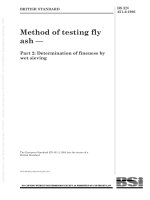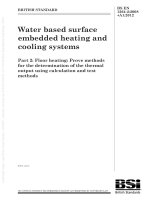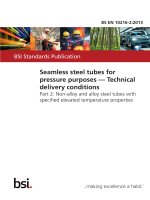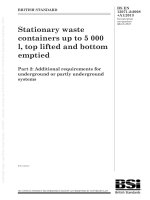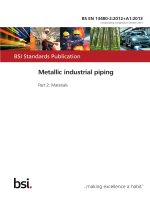Bsi bs en 61496 2 2013
Bạn đang xem bản rút gọn của tài liệu. Xem và tải ngay bản đầy đủ của tài liệu tại đây (1.73 MB, 56 trang )
BS EN 61496-2:2013
BSI Standards Publication
Safety of machinery —
Electro-sensitive protective
equipment
Part 2: Particular requirements for
equipment using active opto-electronic
protective devices (AOPDs)
BRITISH STANDARD
BS EN 61496-2:2013
National foreword
This British Standard is the UK implementation of EN 61496-2:2013. It is
identical to IEC 61496-2:2013. It supersedes DD CLC/TS 61496-2:2006 which
is withdrawn.
The UK participation in its preparation was entrusted to Technical
Committee MCE/3, Safeguarding of machinery.
A list of organizations represented on this committee can be obtained on
request to its secretary.
This publication does not purport to include all the necessary provisions of
a contract. Users are responsible for its correct application.
© The British Standards Institution 2014.
Published by BSI Standards Limited 2014
ISBN 978 0 580 73870 8
ICS 13.110; 29.260.99
Compliance with a British Standard cannot confer immunity from
legal obligations.
This British Standard was published under the authority of the
Standards Policy and Strategy Committee on 28 February 2014.
Amendments/corrigenda issued since publication
Date
Text affected
BS EN 61496-2:2013
EN 61496-2
EUROPEAN STANDARD
NORME EUROPÉENNE
EUROPÄISCHE NORM
December 2013
ICS 13.110; 29.260.99
Supersedes CLC/TS 61496-2:2006
English version
Safety of machinery Electro-sensitive protective equipment Part 2: Particular requirements for equipment
using active opto-electronic protective devices (AOPDs)
(IEC 61496-2:2013)
Sécurité des machines Equipements de protection électro-sensibles Partie 2: Exigences particulières à un
équipement utilisant des appareils protecteurs
optoélectroniques actifs (AOPD)
(CEI 61496-2:2013)
Sicherheit von Maschinen Berührungslos wirkende Schutzeinrichtungen Teil 2: Besondere Anforderungen an
Einrichtungen, welche nach dem aktiven optoelektronischen Prinzip arbeiten
(IEC 61496-2:2013)
This European Standard was approved by CENELEC on 2013-07-12. CENELEC members are bound to comply
with the CEN/CENELEC Internal Regulations which stipulate the conditions for giving this European Standard
the status of a national standard without any alteration.
Up-to-date lists and bibliographical references concerning such national standards may be obtained on
application to the CEN-CENELEC Management Centre or to any CENELEC member.
This European Standard exists in three official versions (English, French, German). A version in any other
language made by translation under the responsibility of a CENELEC member into its own language and notified
to the CEN-CENELEC Management Centre has the same status as the official versions.
CENELEC members are the national electrotechnical committees of Austria, Belgium, Bulgaria, Croatia, Cyprus,
the Czech Republic, Denmark, Estonia, Finland, Former Yugoslav Republic of Macedonia, France, Germany,
Greece, Hungary, Iceland, Ireland, Italy, Latvia, Lithuania, Luxembourg, Malta, the Netherlands, Norway, Poland,
Portugal, Romania, Slovakia, Slovenia, Spain, Sweden, Switzerland, Turkey and the United Kingdom.
CENELEC
European Committee for Electrotechnical Standardization
Comité Européen de Normalisation Electrotechnique
Europäisches Komitee für Elektrotechnische Normung
CEN-CENELEC Management Centre: Avenue Marnix 17, B - 1000 Brussels
© 2013 CENELEC -
All rights of exploitation in any form and by any means reserved worldwide for CENELEC members.
Ref. No. EN 61496-2:2013 E
BS EN 61496-2:2013
EN 61496-2:2013
-2-
Foreword
The text of document 44/651/CDV, future edition 3 of IEC 61496-2, prepared by IEC/TC 44 "Safety of
machinery - Electrotechnical aspects" was submitted to the IEC-CENELEC parallel vote and approved
by CENELEC as EN 61496-2:2013.
The following dates are fixed:
–
latest date by which the document has to be implemented at
national level by publication of an identical national
standard or by endorsement
(dop)
2014-06-13
–
latest date by which the national standards conflicting with
the document have to be withdrawn
(dow)
2016-07-12
This document supersedes CLC/TS 61496-2:2006.
EN 61496-2:2013 includes
CLC/TS 61496-2:2006:
the
following
significant
technical
changes
with
respect
to
–
requirements have been corrected and made easier to understand;
–
test procedures have been revised to make them easier to perform and to improve repeatability;
–
guidance is provided for the evaluation and verification of AOPDs using design techniques for
which the test procedures of this part are not sufficient.
This standard is to be used in conjunction with EN 61496-1:2013.
This part supplements or modifies the corresponding clauses in EN 61496-1.
Where a particular clause or subclause of Part 1 is not mentioned in this Part 2, that clause or
subclause applies as far as is reasonable. Where this part states "addition", "modification" or
"replacement", the relevant text of Part 1 is adapted accordingly.
Attention is drawn to the possibility that some of the elements of this document may be the subject of
patent rights. CENELEC [and/or CEN] shall not be held responsible for identifying any or all such
patent rights.
Endorsement notice
The text of the International Standard IEC 61496-2:2013 was approved by CENELEC as a European
Standard without any modification.
-3-
BS EN 61496-2:2013
EN 61496-2:2013
Annex ZA
(normative)
Normative references to international publications
with their corresponding European publications
The following documents, in whole or in part, are normatively referenced in this document and are
indispensable for its application. For dated references, only the edition cited applies. For undated
references, the latest edition of the referenced document (including any amendments) applies.
NOTE When an international publication has been modified by common modifications, indicated by (mod), the
relevant EN/HD applies.
Publication
Year
Title
EN/HD
Year
IEC 60825-1
2007
Safety of laser products Part 1: Equipment classification and
requirements
EN 60825-1
2007
IEC 61496-1
2012
Safety of machinery - Electro-sensitive
protective equipment
Part 1: General requirements and tests
EN 61496-1
2013
IEC 62471
-
Photobiological safety of lamps and lamp
systems
EN 62471
-
ISO 13855
-
Safety of machinery - Positioning of
protective equipment with respect to the
approach speeds of parts of the human
body
EN ISO 13855
-
-
-
High-visibility warning clothing for
professional use - Test methods and
requirements
EN 471
2003
–2–
BS EN 61496-2:2013
61496-2 © IEC:2013
CONTENTS
INTRODUCTION ..................................................................................................................... 6
1
Scope ............................................................................................................................... 7
2
Normative references ....................................................................................................... 7
3
Terms and definitions ....................................................................................................... 8
4
Functional, design and environmental requirements ......................................................... 9
5
4.1 Functional requirements .......................................................................................... 9
4.2 Design requirements ............................................................................................. 11
4.3 Environmental requirements .................................................................................. 14
Testing ........................................................................................................................... 14
6
5.1 General ................................................................................................................. 14
5.2 Functional tests ..................................................................................................... 17
5.4 Environmental tests ............................................................................................... 34
Marking for identification and safe use............................................................................ 42
7
6.1 General ................................................................................................................. 42
Accompanying documents .............................................................................................. 42
Annex A (normative) Optional functions of the ESPE ........................................................... 44
Annex B (normative) Catalogue of single faults affecting the electrical equipment of
the ESPE, to be applied as specified in 5.3 ........................................................................... 48
Annex AA (informative) Type 2 AOPD periodic test configurations ....................................... 49
Bibliography .......................................................................................................................... 51
Index .................................................................................................................................... 52
Figure 1 – Limit area for the protection against the risk of beam bypass ............................... 12
Figure 2 – Limit of vertical and horizontal misalignment ........................................................ 13
Figure 3 – Test piece at 45° .................................................................................................. 18
Figure 4 – Test piece at 90° .................................................................................................. 19
Figure 5 – Verifying sensing function by moving the test piece (TP) through the
detection zone near the emitter, near the receiver/retro-reflector target and at the
midpoint ................................................................................................................................ 19
Figure 6 – Limit values for the effective aperture angle (EAA) ............................................... 21
Figure 7 – Determination of the minimum detection capability ............................................... 22
Figure 8 – Measuring method for EAA (direction) .................................................................. 23
Figure 9 – Prism test to measure EAA of each beam ............................................................ 25
Figure 10 – EAA test using prism .......................................................................................... 26
Figure 11 – Design calculations for a wedge prism ............................................................... 27
Figure 12 – Example of optical subsystem: Emitter on left – Receiver on right ...................... 27
Figure 13 – Example of SMD LED Model .............................................................................. 28
Figure 14 – Example of intensity distribution of emitting element .......................................... 28
Figure 15 – Example of emitter model with beams internally blocked by aperture stop .......... 28
Figure 16 – Example of receiving unit with off axis beam portion reflected internally on
mechanical elements ............................................................................................................ 29
Figure 17 – Example of test piece inside model of optical subsystem with passing
radiation on the receiver ....................................................................................................... 30
BS EN 61496-2:2013
61496-2 © IEC:2013
–3–
Figure 18 – Example of emitting unit adjusted at the limit ...................................................... 31
Figure 19 – Extraneous reflection test with mirror outside of limit area .................................. 32
Figure 20 – AOPD misalignment test .................................................................................... 33
Figure 21 – Light interference test – Direct method ............................................................... 35
Figure 22 – Light interference test – Test set-up with incandescent light source ................... 36
Figure 23 – Light interference test – Test set-up with fluorescent light source ....................... 37
Figure 24 – Light interference test – Test set-up with flashing beacon light source ............... 38
Figure 25 – Light interference test – Test set-up with stroboscopic light source .................... 39
Figure AA.1 – Single beam sensing device ........................................................................... 49
Figure AA.2 – Series connection of single beam sensing devices ......................................... 49
Figure AA.3 – Assembly of multiple beams tested individually............................................... 49
Figure AA.4 – Example of type 2 AOPD with internal test ...................................................... 50
Table 1 – Correspondences of requirements/testing and AOPD designs ............................... 15
Table 2 – Maximum permissible angle of misalignment (in degrees) for a type 2 ESPE
depending on the dimensions of the light curtain ................................................................... 32
Table 3 – Maximum permissible angle of misalignment (in degrees) for a type 4 ESPE
depending on the dimensions of the light curtain ................................................................... 32
–6–
BS EN 61496-2:2013
61496-2 © IEC:2013
INTRODUCTION
Electro-sensitive protective equipment (ESPE) is applied to machinery that presents a risk of
personal injury. It provides protection by causing the machine to revert to a safe condition
before a person can be placed in a hazardous situation.
This part of IEC 61496 provides particular requirements for the design, construction and
testing of electro-sensitive protective equipment (ESPE) for the safeguarding of machinery,
employing active opto-electronic protective devices (AOPDs) for the sensing function.
Each type of machine presents its own particular hazards, and it is not the purpose of this
standard to recommend the manner of application of the ESPE to any particular machine. The
application of the ESPE should be a matter for agreement between the equipment supplier,
the machine user and the enforcing authority; in this context, attention is drawn to the relevant
guidance established internationally, for example, ISO 12100.
Due to the complexity of the technology of ESPEs there are many issues that are highly
dependent on analysis and expertise in specific test and measurement techniques. In order to
provide a high level of confidence, independent review by relevant expertise is recommended.
BS EN 61496-2:2013
61496-2 © IEC:2013
–7–
SAFETY OF MACHINERY –
ELECTRO-SENSITIVE PROTECTIVE EQUIPMENT –
Part 2: Particular requirements for equipment using
active opto-electronic protective devices (AOPDs)
1
Scope
This clause of Part 1 is replaced by the following:
This part of IEC 61496 specifies requirements for the design, construction and testing of
electro-sensitive protective equipment (ESPE) designed specifically to detect persons as part
of a safety-related system, employing active opto-electronic protective devices (AOPDs) for
the sensing function. Special attention is directed to features which ensure that an
appropriate safety-related performance is achieved. An ESPE may include optional safetyrelated functions, the requirements for which are given in Annex A of IEC 61946-1:2012 and
of this part.
This part of IEC 61496 does not specify the dimensions or configurations of the detection
zone and its disposition in relation to hazardous parts for any particular application, nor what
constitutes a hazardous state of any machine. It is restricted to the functioning of the ESPE
and how it interfaces with the machine.
Excluded from this part are AOPDs employing radiation at wavelengths outside the range
400 nm to 1500 nm.
This part of IEC 61496 may be relevant to applications other than those for the protection of
persons, for example, the protection of machinery or products from mechanical damage. In
those applications, additional requirements may be necessary, for example, when the
materials that are to be recognized by the sensing function have different properties from
those of persons.
This part does of IEC 61496 not deal with EMC emission requirements.
2
Normative references
This clause of Part 1 is applicable except as follows:
Additional references:
IEC 60825-1:2007, Safety of laser products – Part 1: Equipment classification and
requirements
IEC 61496-1:2012, Safety of machinery – Electro-sensitive protective equipment – Part 1:
General requirements and tests
IEC 62471, Photobiological safety of lamps and lamp systems
ISO 13855, Safety of machinery – Positioning of safeguards with respect to the approach
speeds of parts of the human body
EN 471:2003, High-visibility warning clothing for professional use – Test methods and
requirements.
–8–
3
BS EN 61496-2:2013
61496-2 © IEC:2013
Terms and definitions
NOTE At the end of this standard there is an index which lists, in alphabetical order, the terms and acronyms
defined in Clause 3 and indicates where they are used in the text.
This clause of Part 1 is applicable except as follows:
Additional definitions:
3.201
active opto-electronic protective device
AOPD
device whose sensing function is performed by opto-electronic emitting and receiving
elements detecting the interruption of optical radiations generated, within the device, by an
opaque object present in the specified detection zone (or for a light beam device, on the axis
of the light beam)
Note 1 to entry: This note applies to the French language only.
3.202
beam centre-line
optical path joining the optical centre of an emitting element to the optical centre of the
corresponding receiving element that is intended to respond to light from that emitting
element during normal operation
Note 1 to entry:
The optical axis of a light beam is not always on the beam centre-line.
Note 2 to entry: Physical displacement of the beam centre-line may occur as a consequence of normal operation
(for example, by the use of a motor-driven mirror).
Note 3 to entry: For an AOPD that operates on a retro-reflective technique, the optical path is defined by the
retro-reflector target together with the emitting and receiving elements.
3.203
effective aperture angle
EAA
maximum angle of deviation from the optical alignment of the emitting element(s) and the
receiving element(s) within which the AOPD continues in normal operation
Note 1 to entry: This note applies to the French language only.
3.204
light beam device
AOPD comprising one or more emitting element(s) and corresponding receiving element(s),
where a detection zone is not specified by the supplier
3.205
light curtain
AOPD comprising an integrated assembly of one or more emitting element(s) and one or more
receiving element(s) forming a detection zone with a detection capability specified by the
supplier
Note 1 to entry: A light curtain with a large detection capability is sometimes referred to as a light grid.
3.206
test piece
opaque cylindrical element used to verify the detection capability of the AOPD
3.207
geometrically restricted optical design
GROD
AOPD using an optic design where
BS EN 61496-2:2013
61496-2 © IEC:2013
–9–
–
the effective aperture angle (EAA) of each emitting and each receiving element does not
exceed the values given in Figure 6 and
–
the axes of the optical beams are parallel and
–
side lobes are minimized and
–
the spacing between beam centre-lines is uniform and
–
the value of detection capability is based on the complete obscuration of at least one
beam for any and all positions of the test piece within the detection zone (see Figure 7).
Note 1 to entry: This note applies to the French language only.
Replacement:
3.3
detection capability
dimension representing the diameter of the test piece which:
–
for a light curtain, will actuate the sensing device when placed in the detection zone;
–
for a single light beam device, will actuate the sensing device when placed in the beam
centre-line;
–
for a multiple light beam device, will actuate the sensing device when placed in any beam
centre-line
Note 1 to entry: The term “detection capability” can also be used to mean the ability to detect a test piece of the
specified diameter.
4
Functional, design and environmental requirements
This clause of Part 1 is applicable except as follows:
4.1
Functional requirements
4.1.2
Sensing function
Replacement:
4.1.2.1
General requirements
The sensing function shall be effective over the detection zone specified by the supplier. No
adjustment of the detection zone, detection capability or blanking function shall be possible
without the use of a key, key-word or tool.
The sensing device of a light curtain shall be actuated and the OSSD(s) shall go to the OFFstate when a test piece in accordance with 4.2.13 is placed anywhere within the detection
zone either static (at any angle) or moving (with the axis of the cylinder normal to the plane of
the detection zone), at any speed between 0 m/s and 1,6 m/s.
The sensing device of a light beam device shall be actuated and the OSSD(s) shall go to the
OFF-state when a test piece in accordance with 4.2.13 is present in the beam centre-line, at
any point throughout the operating distance, with the axis of the cylinder normal to the axis of
the beam.
NOTE The purpose of this requirement is to ensure that the OSSD(s) go to the OFF-state when a person or part
of a person passes through the detection zone or light beam. Based on a dimension of 150 mm and a walking
speed of 1,6 m/s, a minimum OFF time of 80 ms was determined to be adequate.
When the OSSD(s) go to the OFF-state, they shall remain in the OFF-state while the test
piece is present in the detection zone (or light beam) or for at least 80 ms, whichever is
greater.
– 10 –
BS EN 61496-2:2013
61496-2 © IEC:2013
Where the supplier states that an AOPD can be used to detect objects moving at speeds
greater than those specified above, the above requirements shall be met at any speed up to
and including the stated maximum speed(s).
4.1.2.2
4.1.2.2.1
Additional requirements for AOPDs using retro-reflective techniques and for
AOPDs using mixed emitters and receivers in the same assembly
General
AOPDs using retro-reflective techniques where the light beam traverses the detection zone
more than once (over the same path) and AOPDs using mixed emitters and receivers in the
same assembly shall not fail to danger if a reflective object (for example, reflective clothes) is
placed at any position in the detection zone.
NOTE
The use of mirrors to return the light beam is not considered to be a retro-reflective technique.
4.1.2.2.2
Sensing function
The OSSD(s) shall go to the OFF-state when a reflective object of a size equal to, or greater
than, the diameter and length of the test piece (see 4.2.13) is placed in the detection zone at
any position as specified in 5.2.1.4.
For a type 4 AOPD, under normal operating conditions, the OSSD(s) shall go to the OFF-state
when a reflective object, as specified in 5.2.1.4 is placed as close as practicable in front of
the sensing surface of the emitting/receiving elements.
4.1.3
Types of ESPE
Replacement:
In this part of IEC 61496, only type 2 and type 4 ESPEs are considered. The types differ in
their performance in the presence of faults and under influences from environmental
conditions. In Part 1, the effects of electrical and electromechanical faults are considered
(such faults are listed in Annex B, Part 1). It is the responsibility of the machine manufacturer
and/or the user to determine which type is required for a particular application.
A type 2 ESPE shall fulfil the fault detection requirements of 4.2.2.3.
For a type 2 ESPE, in normal operation the output circuit of at least one output signal
switching device shall go to the OFF-state when the sensing function is actuated, or when
power is removed from the ESPE.
A type 2 ESPE shall have a means of periodic test.
A type 4 ESPE shall fulfil the fault detection requirements of 4.2.2.5 of IEC 61496-1:2012.
For type 4 ESPE, in normal operation the output circuit of at least two output signal switching
devices shall go to the OFF-state when the sensing function is actuated, or when power is
removed from the ESPE.
When a single safety-related data interface is used to perform the functions of the OSSD(s),
then the data interface and associated safety-related communication interface shall meet the
requirements of 4.2.4.4 of IEC 61496-1:2012. In this case, a single safety-related data
interface can substitute for two OSSDs in a type 4 ESPE.
BS EN 61496-2:2013
61496-2 © IEC:2013
4.2
– 11 –
Design requirements
4.2.2
Fault detection requirements
4.2.2.3
Particular requirements for a type 2 ESPE
Addition:
The periodic test shall verify that each light beam operates in the manner specified by the
supplier.
Different configurations are considered that differ in the way the testing of the safety related
performance is carried out.
Annex AA, Figures AA.1, AA.2 and AA.3 are examples of type 2 AOPDs where the periodic
test is externally initiated and the results are externally evaluated. Annex AA, Figure AA.4 is
an example of a type 2 AOPD where the periodic test is automatically initiated and evaluated
internally.
For a type 2 AOPD where the periodic test is internally initiated and evaluated, single faults
that lead to the loss of the automatically initiated internal test shall be detected and shall
result in a lock-out condition.
4.2.2.4
Particular requirements for a type 3 ESPE
This subclause of Part 1 is not applicable.
Additions:
4.2.12
Integrity of the AOPD detection capability
The design of the AOPD shall be such that the AOPD detection capability does not change
from the value stated by the supplier when the AOPD is operated under any and all
combinations of the following:
–
any condition within the specification of the supplier;
–
the environmental conditions specified in 4.3;
–
at the limits of alignment and/or adjustment;
–
over the entire detection zone.
If a single fault (as specified in Annex B of IEC 61496-1:2012), which under normal operating
conditions (see 5.1.2.1 of IEC 61496-1:2012) would not result in a loss of AOPD detection
capability but, when occurring with a combination of the conditions specified above, would
result in such a loss, that fault together with that combination of conditions shall be
considered as a single fault, and the AOPD shall respond to such a single fault as required in
4.2.2.
The AOPD shall be designed and constructed to:
a) limit the possibility of failure to danger resulting from extraneous reflections (for operating
range up to 3 m, see Figure 1);
b) limit the misalignment at which normal operation is possible.
For an operating range of 3 m the limits of Figure 2 shall be met;
c) limit the possibility of malfunction during exposure to extraneous light in the range of
400 nm to 1 500 nm.
BS EN 61496-2:2013
61496-2 © IEC:2013
– 12 –
35°
d
d
L
IEC 100/13
For type 4: d = 131 mm, L = 250 to 3 000 mm
For type 2: d = 262 mm, L = 500 to 3 000 mm
NOTE In this figure, extraneous reflections from surfaces outside the shaded area will not cause a failure to
danger. For short ranges (250 mm for type 4 and 500 mm for a type 2), the angle of 35° is a limit selected by the
working group based on known designs of AOPDs.
Figure 1 – Limit area for the protection against the risk of beam bypass
If the AOPD is intended to provide protection when mounted very close to a reflective surface
(i.e. inside the shaded area of Figure 1), the AOPD shall be designed in such a manner that
no optical bypassing can occur on the reflective surfaces. For such a device, an EAA much
less than 2,5° (for example, less than 0,1°) can be necessary. In this case, Figure 1 does not
apply and the limits of protection against optical bypassing shall be as specified by the
manufacturer.
BS EN 61496-2:2013
61496-2 © IEC:2013
– 13 –
35°
2d
d
d
L
IEC 101/13
For type 4: 2d = 262 mm, L = 3 000 mm
For type 2: 2d = 524 mm, L = 3 000 mm
Figure 2 – Limit of vertical and horizontal misalignment
4.2.13
Test piece
The test piece shall be cylindrical and opaque, with a minimum effective length of 150 mm.
The diameter of the test piece shall not exceed the AOPD detection capability stated by the
supplier.
For AOPDs using retro-reflective techniques and for AOPDs using mixed emitter/receivers in
the same assembly (see 4.1.2.2), the surface of the opaque test piece shall be:
–
a retro-reflecting material conforming
EN 471 class 2 or equivalent;
to
the
requirements
for
retro-reflection
of
NOTE Table 5 in EN 471:2003 defines the minimum coefficient of retro-reflection for class 2 material as
330 cd lx -1 m -2 with an entrance angle of 5° and an observation angle of 0,2° (12').
–
a mirror-type reflective surface having a reflection factor greater than or equal to 90 % at
the operating wavelength, for example, polished chrome plating or polished aluminium;
–
a diffuse reflective surface, white with a coefficient of diffuse reflectance in the range of
80 % to 90 % at the wavelength of the emitter. Example of suitable material is white
paper.
For an AOPD detection capability of not more than 40 mm, the test piece for a light curtain
shall be provided by the supplier and shall be marked with the following:
–
diameter in millimetres;
–
type reference and an indication of the AOPD with which the test piece is intended to be
used.
When more than one detection capability can be configured on the AOPD, the supplier shall
provide a test piece for each detection capability.
– 14 –
BS EN 61496-2:2013
61496-2 © IEC:2013
Verification shall be by inspection.
4.2.14
Wavelength
AOPDs shall operate at a wavelength within the range 400 nm to 1 500 nm.
4.2.15
Radiation intensity
If the emitting device uses LED technology, the radiation intensity generated and emitted by
the AOPD shall meet the requirements of exempt group in accordance to IEC 62471.
NOTE 1
Exempt group is equal to risk group zero (IEC 62471).
If the emitting device uses laser technology, the radiation intensity generated and emitted by
the AOPD shall at no time exceed the accessible emission limits (AEL) for a class 1M device
in accordance with 8.2 of IEC 60825-1:2007.
NOTE 2
4.3
Class 2 devices may be used for alignment or adjustment.
Environmental requirements
Addition:
4.3.5
Light interference
The ESPE shall continue in normal operation when subjected to
–
incandescent light;
–
flashing beacons;
–
fluorescent light operated with high-frequency electronic power supply.
The ESPE shall not fail to danger when subjected to
–
incandescent light (simulated daylight using a quartz lamp);
–
stroboscopic light;
–
fluorescent light operated with high-frequency electronic power supply;
–
for a type 4 AOPD, radiation from an emitting assembly (or element ) of identical design.
Combination of technical measures and installation and configuration procedures in
accordance with the information for use provided by the manufacturer shall be tested.
NOTE For type 2 AOPDs the risk of failure to danger from an emitting element of identical design can be reduced
by installation measures supplied by the manufacturer.
These requirements shall be met when the AOPD conforms to the tests in 5.4.6.
No requirements are given for immunity to other extraneous light sources which may cause
abnormal operation or failure to danger. A requirement for the supplier to inform the user of
potential problems is given in (ff) of Clause 7 (in this part and IEC 61496-1:2012).
5
Testing
This clause of Part 1 is applicable except as follows:
5.1
General
Addition:
In the following tests, it shall be verified that when the OSSD(s) go to the OFF-state, they
remain in the OFF-state while the test piece is present in the detection zone (or light beam) or
BS EN 61496-2:2013
61496-2 © IEC:2013
– 15 –
for at least 80 ms, whichever is greater. If the AOPD incorporates a restart interlock, the
restart interlock shall be disabled during the tests of this clause.
AOPD may be designed in different ways. The following Table 1 shows the different designs
and corresponding requirements and tests as described within this standard.
Table 1 – Correspondences of requirements/testing and AOPD designs
Different AOPD designs
Subclause
Requirements
and tests
AOPD using only
emitters or only
receivers in the same
assembly
AOPD using retroreflective techniques
AOPD using emitters
and receivers in the
same assembly
GROD
Unrestricted
optical
design
GROD
Unrestricted
optical
design
GROD
Unrestricted
optical
design
4.1
Functional
requirements
X
X
X
X
X
X
4.1.2
Sensing function
X
X
X
X
X
X
4.1.2.2
Additional
requirements for
AOPDs using
retro-reflective
techniques and for
AOPDs using
mixed emitters
and receivers in
the same
assembly
X
X
X
X
4.2
Design
requirements
X
X
X
X
X
X
4.2.2
Fault detection
requirements
X
X
X
X
X
X
4.2.12
Integrity of the
AOPD detection
capability
X
X
X
X
X
X
4.2.13
Test piece
X
X
X
X
X
X
4.2.14
Wavelength
X
X
X
X
X
X
4.2.15
Radiation intensity
X
X
X
X
X
X
4.3
Environmental
requirements
X
X
X
X
X
X
4.3.5
Light interference
X
X
X
X
X
X
5
Testing
X
X
X
X
X
X
5.1
General
X
X
X
X
X
X
5.1.1
Type tests
X
X
X
X
X
X
5.1.1.2
Operating
condition
X
X
X
X
X
X
5.1.2
Test conditions
X
X
X
X
X
X
5.1.2.2
Measurement
accuracy
X
X
X
X
X
X
5.2
Functional tests
X
X
X
X
X
X
5.2.1.
Sensing function
X
X
X
X
X
X
5.2.1.2.2
Analysis of the
electro-optical
subsystem
X
X
X
X
X
X
BS EN 61496-2:2013
61496-2 © IEC:2013
– 16 –
Different AOPD designs
AOPD using only
emitters or only
receivers in the same
assembly
AOPD using retroreflective techniques
AOPD using emitters
and receivers in the
same assembly
GROD
Unrestricted
optical
design
GROD
Unrestricted
optical
design
GROD
Unrestricted
optical
design
Verification of the
electro-optical
subsystem for
GROD
X
X
X
X
X
X
5.2.1.2.4
EAA test of GROD
X
X
X
5.2.1.2.5
Prism test for
GROD
X
X
X
5.2.1.3
Verification of the
electro-optical
subsystem for
technologies other
than GROD
X
X
X
Modelling and
verification of
optical subsystem
model
X
X
X
Analysis of the
detection
capability by
simulation
X
X
X
5.2.1.3.4
Additional tests of
detection
capability
X
X
X
5.2.1.3.5
Analysis of
extraneous
reflections
X
X
X
5.2.1.3.6
Extraneous
reflections test
X
X
X
5.2.1.3.7
Misalignment test
X
X
X
5.2.1.4
Additional tests
for an AOPD using
retro-reflective
techniques and for
AOPDs using
mixed emitter and
receivers in the
same assembly
Subclause
5.2.1.2.3
5.2.1.3.2
5.2.1.3.3
Requirements
and tests
X
X
X
X
5.4
Environmental
tests
X
X
X
X
X
X
5.4.6
Light interference
X
X
X
X
X
X
5.4.6.1
General
X
X
X
X
X
X
5.4.6.2
Light sources
X
X
X
X
X
X
5.4.6.3
Test sequences
X
X
X
X
X
X
5.4.6.4
Normal operation
(best alignment)
X
X
X
X
X
X
5.4.6.5
Failure to danger
– Incandescent
light (3 000 lux
and worst-case
alignment)
X
X
X
X
X
X
BS EN 61496-2:2013
61496-2 © IEC:2013
– 17 –
Different AOPD designs
Subclause
5.4.6.6
5.4.6.7
5.4.6.8
5.1.1
AOPD using only
emitters or only
receivers in the same
assembly
AOPD using retroreflective techniques
AOPD using emitters
and receivers in the
same assembly
GROD
Unrestricted
optical
design
GROD
Unrestricted
optical
design
GROD
Unrestricted
optical
design
Failure to danger
– Stroboscopic
light (worst-case
alignment)
X
X
X
X
X
X
Failure to danger
– Fluorescent light
(3 000 lux and
worst-case
alignment)
X
X
X
X
X
X
Failure to danger
– Interfering light
from an emitting
element of
identical design
X
X
X
X
X
X
Requirements
and tests
Type tests
5.1.1.2
Operating condition
Addition:
For the purpose of these tests, the plane of the light curtain detection zone may be either
vertical or horizontal as preferred for a test.
If it can be demonstrated that the results will be the same, testing at long operating distances
may be simulated by the use of neutral density filters.
5.1.2
Test conditions
5.1.2.2
Measurement accuracy
Addition to first paragraph:
–
for angular measurement:
± 0,1°;
–
for light intensity measurement:
± 10 %.
5.2
Functional tests
5.2.1
Sensing function
Replacement:
5.2.1.1
General
It shall be verified that the sensing device is continuously actuated and, where appropriate,
that the OSSD(s) go to the OFF-state, taking into account the operating principle of the AOPD
and, in particular, the techniques used to provide tolerance to environmental interference.
For a light curtain:
–
by slowly moving the test piece in the detection zone across the beams at an angle of 45°
and at an angle of 90° (see Figures 3 and 4) at each end of the detection zone [as near as
BS EN 61496-2:2013
61496-2 © IEC:2013
– 18 –
practical to the emitter and receiver (or retro-reflector)] and midway between the ends
(see Figure 5);
–
by placing the test piece in the detection zone, stationary, at any position and/or angle
considered critical as a result of the analysis in 5.2.1.2.2
–
by moving the test piece in the detection zone, across the beams at the maximum speed
in the range specified in 4.1.2.1, and at any other speed in that range which is considered
critical as a result of the analysis in 5.2.1.2.2;
–
by moving the test piece (having a length of 150 mm) through the detection zone at
1,6 m/s such that the direction of movement and the axis of the test piece are normal to
the detection plane, at the extremities of the detection zone (for example, at each corner)
and in any other position that is considered critical as a result of the analysis in 5.2.1.2.2.
For a light beam device:
–
by placing the test piece in the beam at each end of the beam and midway along the beam
such that the axis of the test piece is normal to the axis of the beam;
–
by moving the test piece (having a length of 150 mm) through the beam at 1,6 m/s such
that the direction of movement and the axis of the test piece are normal to the axis of the
beam, at each end of the beam midway along the beam, and at any point throughout the
operating distance which is considered critical as a result of the analysis in 5.2.1.2.2.
The above tests shall be performed with the AOPD operating at the minimum specified
operating distance or 0,5 m, whichever is the greater, and at the maximum specified operating
distance.
Detection zone of a light curtain
shown with light beams normal
to the page
Test piece
45°
Figure 3 – Test piece at 45°
IEC 102/13
BS EN 61496-2:2013
61496-2 © IEC:2013
– 19 –
Detection zone of a light curtain
shown with light beams normal
to the page
Test piece (90°)
IEC 103/13
Figure 4 – Test piece at 90°
TP
TP
TP
IEC 104/13
Figure 5 – Verifying sensing function by moving the
test piece (TP) through the detection zone near the emitter,
near the receiver/retro-reflector target and at the midpoint
5.2.1.2
5.2.1.2.1
Verification of integrity of detection capability
General
It shall be verified that the AOPD detection capability is continuously maintained or the ESPE
does not fail to danger, by systematic analysis of the design of the AOPD, using testing where
appropriate, taking into account all combinations of the conditions specified in 4.1.2, 4.2.12
and the faults specified in 5.3 of IEC 61496-1:2012.
– 20 –
5.2.1.2.2
BS EN 61496-2:2013
61496-2 © IEC:2013
Analysis of the electro-optical subsystem
A systematic analysis of the electro-optical subsystem shall be carried out to determine:
a) the beam centre-line and the optical axes of the emitting and receiving elements;
b) the spacing between beam centre lines;
c) the characteristics of the optical assemblies (e.g. lens diameter, focal length, position and
dimension of the stops, shape of the lens holder)
d) the relative intensity/sensitivity of the beams in the multi-beam devices;
e) beam direction and orientation between similar elements (i.e. between one emitting
subassembly and another, or between one receiving subassembly and another);
f)
the criteria used to determine the status of the sensing function.
The results of this analysis shall be used to determine which method is appropriate for the
verification of the electro-optical subsystem and verification for integrity of detection
capability.
If the analysis shows that all the criteria in 5.2.1.2.3 are met, then 5.2.1.2.3, 5.2.1.2.4 and
5.2.1.2.5 shall be used.
In all the other cases or if the analysis shows that one or more of the criteria in 5.2.1.2.3 are
not met, then 5.2.1.3 (including 5.2.1.3.1 to 5.2.1.3.7) shall be used.
5.2.1.2.3
Verification of the electro-optical subsystem for GROD
GROD achieves the requirements specified in 4.2.12 by ensuring that
–
the effective aperture angle (EAA) of each emitting and each receiving element does not
exceed the values given in Figure 6 and
–
the axes of the optical beams are parallel and
–
side lobes are minimized and
–
the spacing between beam centre-lines is uniform and
–
the value of detection capability is based on the complete obscuration of at least one
beam for any and all positions of the test piece within the detection zone (see Figure 7)
It shall be verified that all beams meet the following limits.
BS EN 61496-2:2013
61496-2 © IEC:2013
MP4*
– 21 –
MP3
MP2
MP1
αMP1
0,5 m
0,75 m
1,5 m
Beam centre-line
3,0 m (or minimum operating distance when > 3,0 m)
IEC 105/13
Type 2
AOPD
MP1
MP2
MP3
MP4
Type 4
AOPD
MP1
MP2
MP3
MP4
α Limit
values
5
10
19,3
27,7
α Limit
values
2,5
5
10
14,7
degrees
*
degrees
MP measuring point
The effective aperture angle should be determined according to 5.2.1.2.4
Measurements should be carried out at each of the measuring points MP1 to MP4 (or if
minimum distance is greater than 3,0 m, at MP1 only).
NOTE 1
The limit values for intermediate distances between MP1 and MP4 can be calculated using the formula:
α = tan –1 (d/L)
where
d = 262 (for type 2) or d = 131 (for type 4)
and L is the distance between emitter and receiver (or DUT and retro-reflector target).
For distances greater than 3,0 m, use the α limit for MP1.
NOTE 2
For retro-reflector systems, the value of α is one-half of the value shown in the table above.
Figure 6 – Limit values for the effective aperture angle (EAA)
When GROD is used, the formula for determining minimum detection capability (d) is (see
Figure 7):
d=P+φ
where
d = detection capability
P = beam centre-lines spacing
– 22 –
BS EN 61496-2:2013
61496-2 © IEC:2013
φ = lens diameter
EXAMPLE
Lens diameter (φ) = 6 mm and beam spacing (P) = 8 mm
d = P + φ = 8 mm + 6 mm = 14 mm
Therefore, in the above example, detection capability = 14 mm.
Where lens diameters are different, the largest diameter shall be used in the calculation.
Figure 7 – Determination of the minimum detection capability
5.2.1.2.4
EAA test of GROD
With an emitter assembly or an emitter/receiver assembly, fixed in optical alignment with a
receiver assembly or a retro-reflector target, the angle of misalignment of the receiver
assembly or the retro-reflector target shall be measured. With a receiver assembly or retroreflector target fixed in optical alignment with an emitter assembly or an emitter/receiver
assembly, the angle of misalignment of the emitting element or the emitter/receiver element
shall be measured. These measurements shall be carried out at all the distances indicated in
Figure 6 in the following manner.
The AOPD shall be optimally aligned as specified by the supplier. The AOPD should be
mounted on a turntable with an angle scale. The tests shall be performed about the rotational
axis indicated in Figure 8.
BS EN 61496-2:2013
61496-2 © IEC:2013
– 23 –
1) Rotation of the emitter assembly with the receiver assembly fixed
Plane of lenses
Beam centre-line (or plane of beam centre-lines)
DUT*
Receiver assembly
or retro-reflector
Emitter assembly or
emitter/receiver assembly
IEC 107/13
Rotation axis in the plane of all lenses
2) Rotation of the receiver assembly with the emitter assembly fixed
Plane of lenses
Beam centre-line (or plane of beam centre-lines)
DUT*
Operating distance
Emitter assembly or
emitter/receiver assembly
(see NOTE)
*
Receiver assembly
or retro-reflector (see NOTE)
IEC 108/13
DUT: device under test
For light curtains employing retro-reflective techniques, the test should only be carried out on
the sensing unit with the retro-reflector target fixed.
Figure 8 – Measuring method for EAA (direction)
Switch the AOPD on and carry out the procedure as follows:
a)
the emitter or emitter/receiver unit shall be turned clockwise into the 90° position; the
OSSD(s) shall go to the OFF-state;
b) the supply voltages of the complete AOPD shall be switched off and then on again;
Based on the analysis of 5.2.1.2.2, it can be necessary to wait for some time (for example,
settling time of gain control circuits) between the steps of this procedure.
c) the emitter or emitter/receiver unit shall be turned back towards the aligned position until
the position is reached at which the OSSD(s) go to the ON-state. This value of the angle
and distance shall be recorded. Continue turning the unit in the counter-clockwise
direction until the opposite 90° position is reached and record the last position at which
the OSSD(s) change from the ON-state to the OFF-state;
d) the same procedure given in steps a) to c) shall be performed in the counter clockwise
direction;
e) the same procedure given in steps a) to d) shall be applied to the opposite unit (receiver
or receiver/emitter).
In cases where the minimum operating distance specified exceeds 3 m, similar tests shall be
performed to determine the EAA at the minimum operating distance (see Figure 6).
The test is passed when the angles recorded in step c) (EAA) are less than the values
indicated in Figure 6.
For an AOPD specified by the manufacturer to operate over long distances, tests can be
carried out using neutral density filters over shorter distances, when it can be shown that the
results obtained will correspond with those results obtained at the specified operating
distance.

